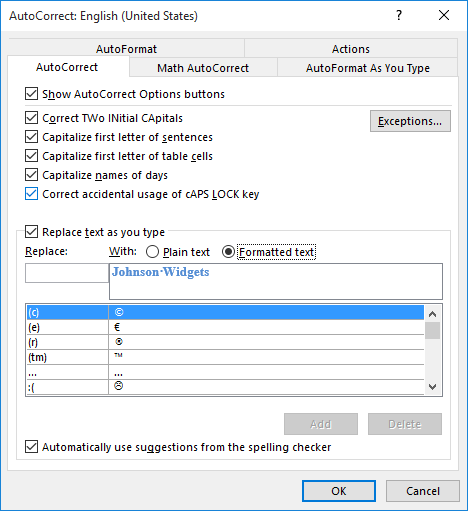Please Note: This article is written for users of the following Microsoft Word versions: 2007, 2010, 2013, 2016, 2019, 2021, and Word in Microsoft 365. If you are using an earlier version (Word 2003 or earlier), this tip may not work for you. For a version of this tip written specifically for earlier versions of Word, click here: Adding Ampersands to Custom Dictionaries.
Written by Allen Wyatt (last updated May 6, 2023)
This tip applies to Word 2007, 2010, 2013, 2016, 2019, 2021, and Word in Microsoft 365
Richard is using the corporate name "at&t" in a document. Word does not like the lowercase name and wants to capitalize it. The wavy green line indicates a grammar issue, and Richard cannot find a way to fix this. He tried editing the custom dictionary but the dictionary would not accept words with ampersands.
It could be that Word kept suggesting capitalizing the name because it really should be capitalized. While the letters "at&t" are used in lowercase in some advertising for the corporate behemoth, it appears that the name really is uppercase. (See the www.att.com Website for examples of this.)
That being said, if you really want to make the letters lowercase without getting any notation that this is incorrect, there are a couple of things you can try. First, and perhaps easiest, is to simply add the letters to the dictionary. Don't do it by trying to add the letters directly, but instead type them in the document, do a spell check, and when the letters are displayed as an error, try to add them at that point. This approach lets Word deal with how the letters should be specifically added to the dictionary.
If this doesn't work for some reason, you can employ AutoCorrect to help you out. Follow these general steps:

Figure 1. The AutoCorrect tab of the AutoCorrect dialog box.
Now, when you type at&t, AutoCorrect kicks in and replaces the letters with the formatted version. How are they formatted? To ignore spelling and grammar checks, so the wavy underlines never appear.
WordTips is your source for cost-effective Microsoft Word training. (Microsoft Word is the most popular word processing software in the world.) This tip (11205) applies to Microsoft Word 2007, 2010, 2013, 2016, 2019, 2021, and Word in Microsoft 365. You can find a version of this tip for the older menu interface of Word here: Adding Ampersands to Custom Dictionaries.

Learning Made Easy! Quickly teach yourself how to format, publish, and share your content using Word 2021 or Microsoft 365. With Step by Step, you set the pace, building and practicing the skills you need, just when you need them! Check out Microsoft Word Step by Step today!
AutoCorrect can be a great tool to correct, automatically, the typos and wording you enter in a document. Sometimes, ...
Discover MoreThe AutoCorrect tool in Word is a great help in making sure that all instances of a name (such as a newspaper name) are ...
Discover MoreSometimes it could be helpful to have Word substitute two characters for the one that you type, for instance, to replace ...
Discover MoreFREE SERVICE: Get tips like this every week in WordTips, a free productivity newsletter. Enter your address and click "Subscribe."
There are currently no comments for this tip. (Be the first to leave your comment—just use the simple form above!)
Got a version of Word that uses the ribbon interface (Word 2007 or later)? This site is for you! If you use an earlier version of Word, visit our WordTips site focusing on the menu interface.
Visit the WordTips channel on YouTube
FREE SERVICE: Get tips like this every week in WordTips, a free productivity newsletter. Enter your address and click "Subscribe."
Copyright © 2026 Sharon Parq Associates, Inc.
Comments